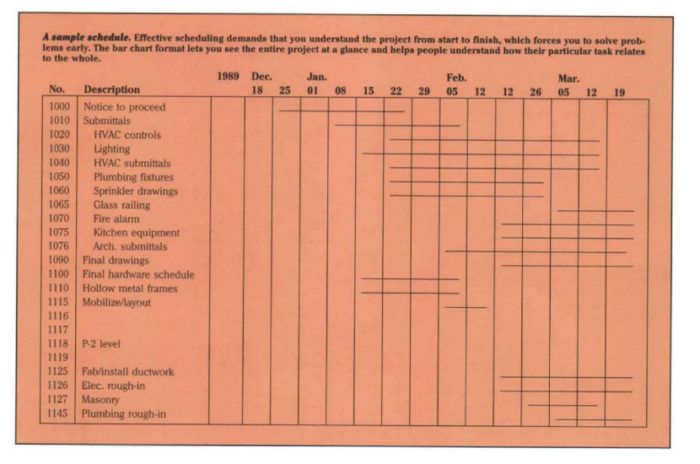Job Closeout
Finishing on schedule and within budget demands careful planning at the start.

Synopsis: Observing that most carpentry projects stall somewhat short of completion, a Washington, D.C., based project manager outlines a plan for taking care of all the loose ends to stay on time and on budget.
Like a bad dream, a prybar tumbled from the mantel in slow motion, shattering the Italian marble hearth below. This is exactly how a good job goes bad.
Blame it on poor communication. My company had been doing a large interior woodworking project. We were almost finished and anxiously looked forward to our next job, when the owner asked us to build a fireplace mantel. After sketching a few ideas on the wood subfloor, we agreed on a design and a price.
A week later, just as the second coat of varnish had begun to harden, the owner returned to inspect the project. With a look of horror on her face she told me that it was much too large. I started to motion toward our original sketch, but realized that it had vanished beneath the marble hearth that had been set the day before. We argued, but in the interest of a peaceful settlement, I agreed to change the size of the mantel. In my haste to make the change I guess I was careless: the prybar fell, and the nightmare began.
The tile setter informed me that it would take six weeks to get a new marble hearth. Weeks stretched out into months, however, and three months later a frustrated contractor— myself—received final payment less drywall, paint and marble repairs from an equally frustrated owner. There’s an old saying among builders that all jobs reach 90% completion and then stay there forever. This job seemed to prove it. Why is it so hard to finish?
Starting out right
As builders, we focus most of our attention on getting and managing the work. As a result, we give too little thought to the final stages of the job. This lack of planning costs us dearly. We spend countless hours either correcting work that should have been done right the first time, or modifying designs that weren’t quite right, or waiting months for light fixtures that we thought we’d get right away. This excruciating process of trying to finish is called “job closeout.”
The firm that I work for recently studied job closeout. We discovered that we spend 20% of a typical project’s overhead on the final 5% of the work. A marketing survey also showed us that our inability to finish jobs promptly affected our clients’ perceptions of us. They likened a contractor who spends too much time on the job to a child who won’t leave home. In other words, our poor performance at job close out was costing us money and references. We discussed the problem with clients, subcontractors, accountants, architects, engineers— even our spouses—and concluded that the real trick to finishing on time is getting started properly. That means scheduling intelligently and taking time to educate clients and subcontractors about the job schedule and the building process. It also means actively managing quality at all stages and controlling the final punch list (a list of items to be corrected or completed before the job is considered complete). The big payoff comes at the end because the more time you spend up front, the easier it is to finish.
For checklists and more details on staying on budget, click the View PDF button below.
Fine Homebuilding Recommended Products
Fine Homebuilding receives a commission for items purchased through links on this site, including Amazon Associates and other affiliate advertising programs.

Code Check 10th Edition: An Illustrated Guide to Building a Safe House

A House Needs to Breathe...Or Does It?: An Introduction to Building Science

The New Carbon Architecture: Building to Cool the Climate

























